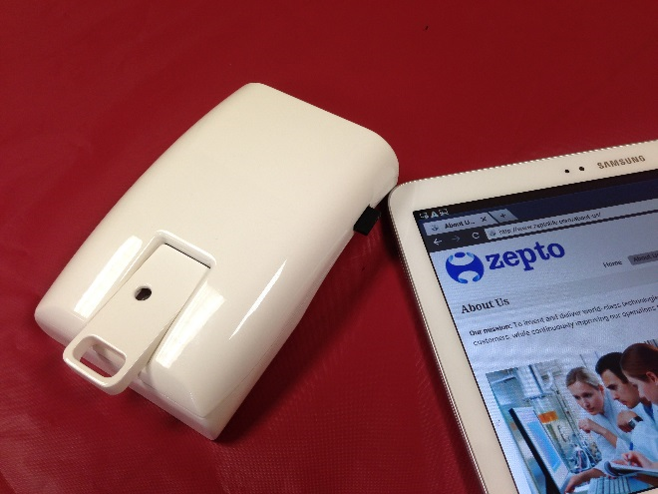Golden Gopher Magnetic Biosensing

Technology Invovation
Z-Lab is a magnetic biosensing system that has detected biomarkers in unprocessed human serum and urine, heavy metals like mercury (2+) in lake water. Ultra high sensitivity (up to 200 molecules per magnetic sensor) has been demonstrated. The Golden Gopher Magnetic Biosensing Team has also begun to develop z-Lab 2.0 and z-Lab 3.0, which are smaller, more versatile, and more portable versions of z-Lab.
Team Story
Researchers from the University of Minnesota, Mayo Clinic, and several companies – a GMR biosensing start-up company (Zepto Life Technology LLC), a start-up company which fabricates magnetic nanoparticles (Universal Magnetic System LLC), a large biological and assay development company (R&D Systems), an audio electronics repair company (Jim Sawyer Professional Audio Service), and a mechanical design company (Vates) – teamed up to form the Golden Gopher Magnetic Biosensing Team. Inspired by Dr. Jian-Ping Wang's vision of a low-cost, easy-to-use, accurate, portable GMR biosensing system, they have contributed their areas of expertise to build z-Lab and begin to design and construct z-Lab 2.0 and z-Lab 3.0.

About Our Team Leader
Selected Publications
- Su, D., Wu, K., Saha, R., Peng, C., & Wang, J. P. (2020). Advances in Magnetoresistive Biosensors. Micromachines, 1
1(1), 34. - Klein, T., Wang, W., Yu, L., Wu, K., Boylan, K. L., Vogel, R. I., ... & Wang, J. P. (2019). Development of a multiplexed giant magnetoresistive biosensor array prototype to quantify ovarian cancer biomarkers. Biosensors and Bioelectronics, 126, 301-307.
- Su, D., Wu, K., Krishna, V., Klein, T., Liu, J., Feng, Y., ... & Wang, J. P. (2019).Detection of influenza a virus in swine nasal swab samples with a wash-free magnetic bioassay and a handheld giant magnetoresistance sensing system. Frontiers in Microbiology, 10, 1077.
- Wu, K., Klein, T., Krishna, V. D., Su, D., Perez, A. M., & Wang, J. P. (2017). Portable GMR handheld platform for the detection of influenza A virus. ACS sensors, 2(11), 1594-1601.
- Krishna, V. D., Wu, K., Perez, A. M., & Wang, J. P. (2016). Giant magnetoresistance-based biosensor for detection of influenza A virus. Frontiers in microbiology, 7, 400.
- Wang, Y., Wang, W., Yu, L., Tu, L., Feng, Y., Klein, T., & Wang, J. P. (2015). Giant magnetoresistive-based biosensing probe station system for multiplex protein assays. Biosensors and Bioelectronics, 70, 61-68.
- Klein, T., Wang, Y., Tu, L., Yu, L., Feng, Y., Wang, W., & Wang, J. P. (2014). Comparative analysis of several GMR strip sensor configurations for biological applications. Sensors and Actuators A: Physical, 216, 349-354.
- Wang, W., Wang, Y., Tu, L., Feng, Y., Klein, T., & Wang, J. P. (2014). Magnetoresistive performance and comparison of supermagnetic nanoparticles on giant magnetoresistive sensor-based detection system. Scientific reports, 4(1), 1-5.
- Li, Y., Wang, Y., Klein, T., & Wang, J. P. (2014). External-field-free magnetic biosensor. Applied Physics Letters, 104(12), 122401.
- Wang, W., Wang, Y., Tu, L., Klein, T., Feng, Y., Li, Q., & Wang, J. P. (2014). Magnetic detection of mercuric ion using giant magnetoresistance-based biosensing system. Analytical chemistry, 86(8), 3712-3716.
- Wang, W., Wang, Y., Tu, L., Klein, T., Feng, Y., & Wang, J. P. (2012). Surface modification for protein and DNA immobilization onto GMR biosensor. IEEE transactions on magnetics, 49(1), 296-299.
- Srinivasan, B., Li, Y., Jing, Y., Xing, C., Slaton, J., & Wang, J. P. (2011). A three-layer competition-based giant magnetoresistive assay for direct quantification of endoglin from human urine. Analytical chemistry, 83(8), 2996-3002.
- Srinivasan, B., Li, Y., Jing, Y., Xu, Y., Yao, X., Xing, C., & Wang, J. P. (2009). A detection system based on giant magnetoresistive sensors and high moment magnetic nanoparticles demonstrates zeptomole sensitivity: Potential for personalized medicine. Angewandte Chemie International Edition, 48(15), 2764-2767






